Honor Award
Lafayette Greens: Urban Agriculture, Urban Fabric, Urban Sustainability
Detroit
Kenneth Weikal Landscape Architecture, Farmington Hills, MI
Client: Compuware Corporation
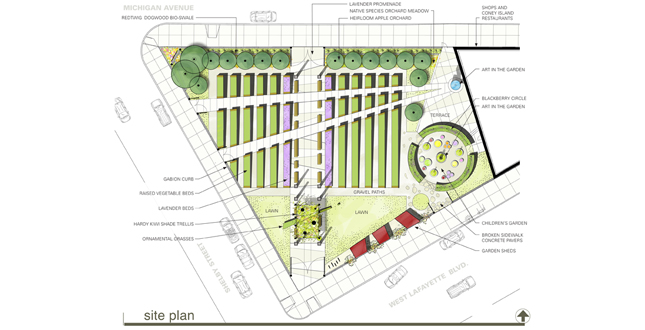
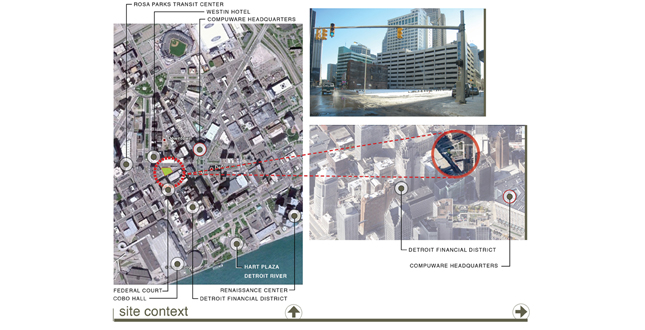
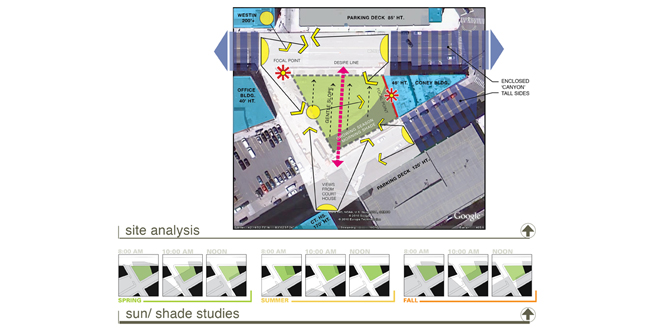
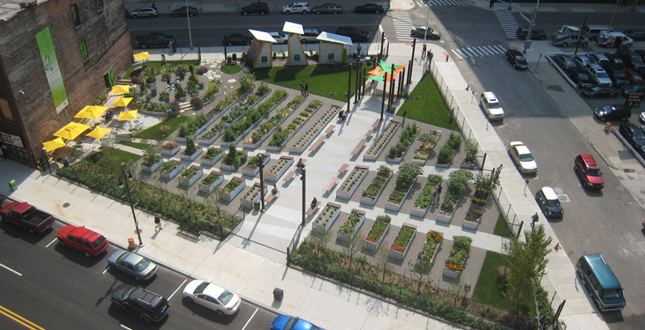
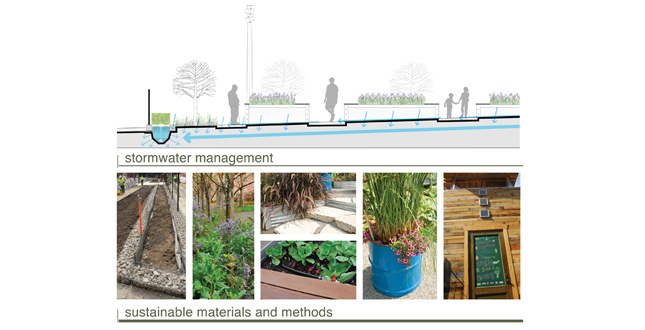 Close Me!
Close Me!Stormwater Management & Sustainable Materials and Methods.
Download Hi-Res ImageImage: Beth Hagenbuch BLA
Image 5 of 16
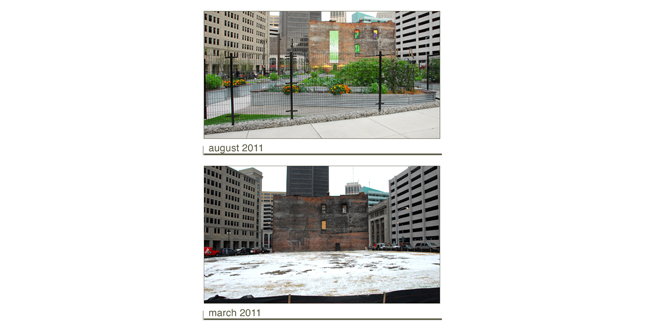 Close Me!
Close Me!A gabion curb defines the garden boundaries and illustrates an unexpected use of recycled materials. A transparent fence was chosen to convey a welcoming and inclusive message, appropriate to a community space.
Download Hi-Res ImageImage: Beth Hagenbuch BLA
Image 6 of 16
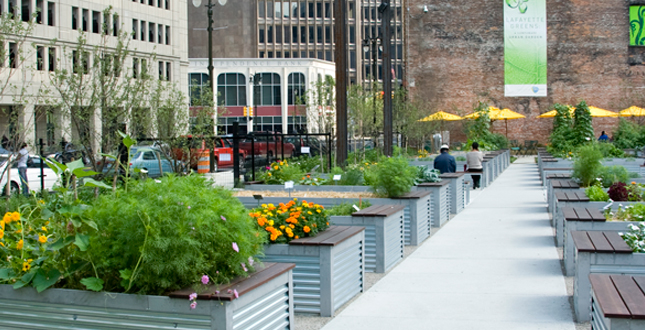 Close Me!
Close Me!Steel vegetable beds with Massaranduba seating line one of the walks to the Sunflower Terrace.
Download Hi-Res ImageImage: Beth Hagenbuch BLA
Image 7 of 16
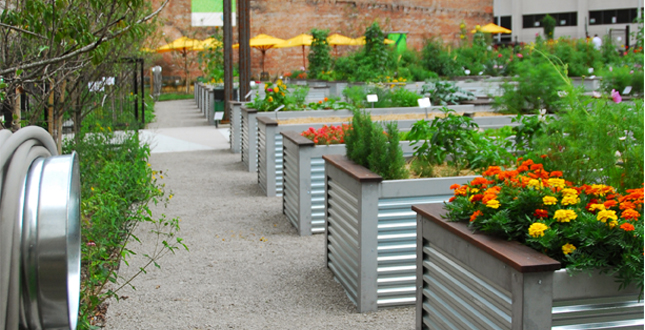 Close Me!
Close Me!Custom designed galvanized steel planters and I-beam light poles by the Landscape Architects. The historic brick wall and industrial materials evoke Detroit’s past, while vegetables and community participation look to the future.
Download Hi-Res ImageImage: Beth Hagenbuch BLA
Image 8 of 16
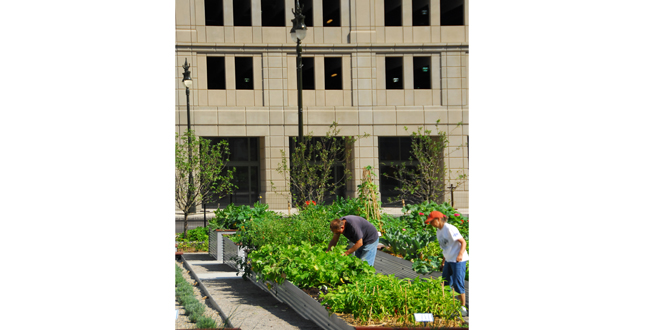
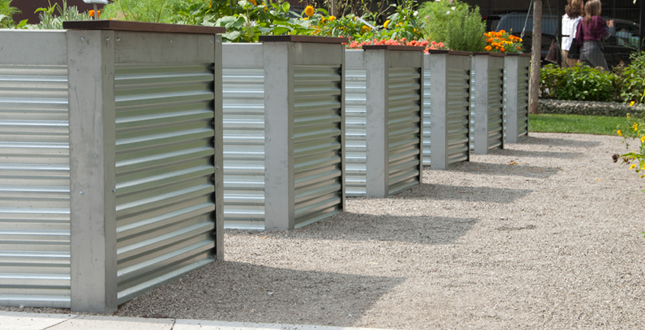 Close Me!
Close Me!Steel vegetable beds facing the apple orchard. Raised beds have adjustable drip irrigation lines.
Download Hi-Res ImageImage: Beth Hagenbuch BLA
Image 10 of 16
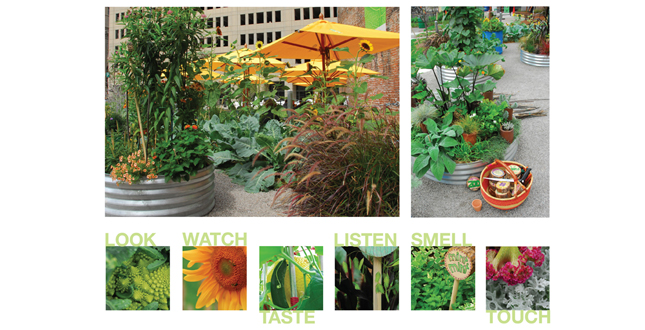 Close Me!
Close Me!Modeled after Will Allen’s Growing Power facility in Milwaukee, The Fair Market Farm introduces fresh food, employment and community space into the neighborhood. The proposed location anticipates the advantages of being close to the Triangle Business District and Woodward Avenue.
Download Hi-Res ImageImage: Beth Hagenbuch BLA
Image 11 of 16
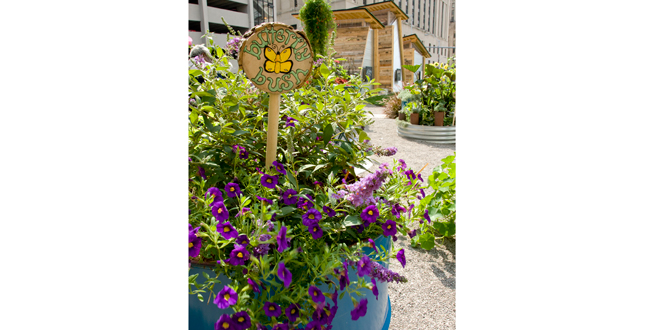 Close Me!
Close Me!In The Children’s Garden looking towards the garden sheds with the Federal Court Building in the background.
Download Hi-Res ImageImage: Beth Hagenbuch BLA
Image 12 of 16
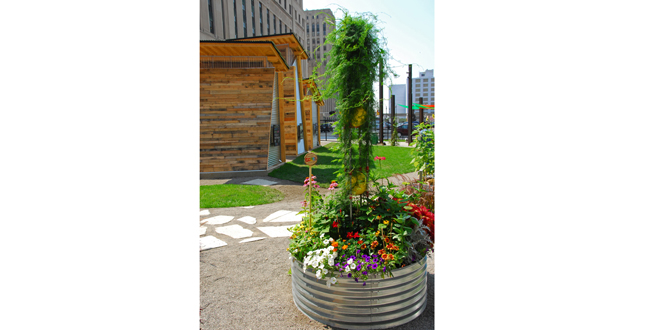
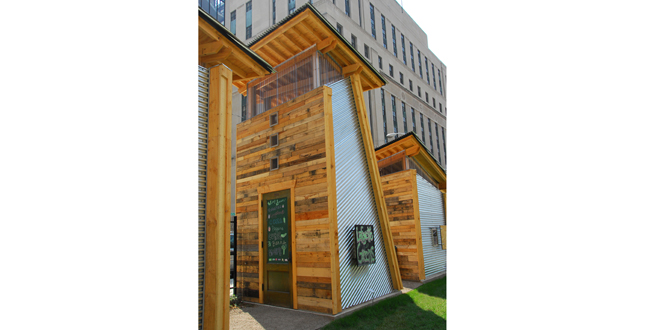 Close Me!
Close Me!Garden sheds designed by the Landscape Architects are clad with recycled pallet wood and have salvaged doors with chalkboard panels. At night the sheds glow with a soft interior light.
Download Hi-Res ImageImage: Beth Hagenbuch BLA
Image 14 of 16
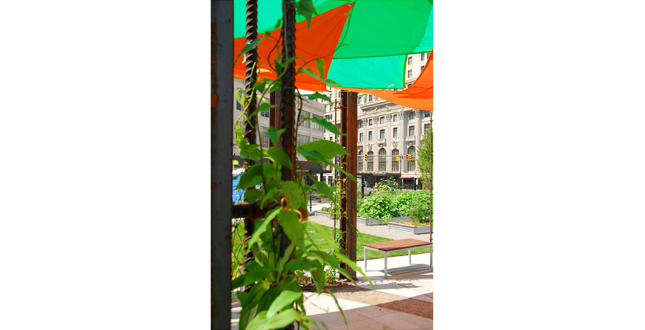 Close Me!
Close Me!Under the Hardy Kiwi Trellis on the promenade. The Kiwi vines are just beginning to climb their specially designed I-beam and rebar supports. Specially fabricated benches line the Lavender Promenade
Download Hi-Res ImageImage: Beth Hagenbuch BLA
Image 15 of 16
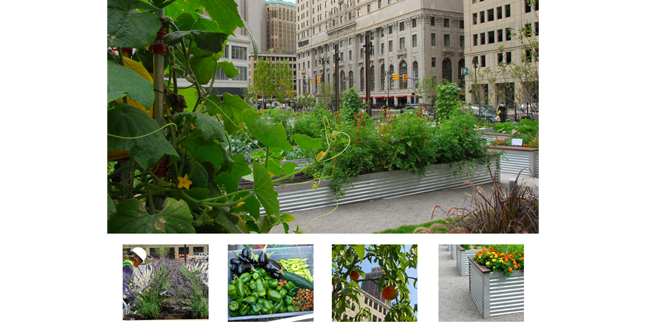
Project Statement
Interest and excitement about urban farming is gaining momentum. This corporate sponsored urban garden brings urban agriculture, community gardening, productive landscapes and the entire conversation about the food movement into the heart of downtown Detroit. A productive vegetable garden that also functions as an engaging public space, it is a tangible expression of the possibilities for integrating urban agriculture into city spaces and city life in a way that is participatory, beautiful and productive.
Project Narrative
—2012 Professional Awards Jury
This .425 acre garden fills a parcel of city land left vacant after the 2010 demolition of the historic Lafayette Building in downtown Detroit. Just a one block walk from Compuware headquarters, adjacent to the financial district and bordered by the Detroit Federal Building and the renovated Westin Book Cadillac Hotel, this vegetable garden fills a busy and highly visible urban setting. The loss of the Lafayette building left the city looking to future development and city inhabitants unhappy with a depressing empty lot. Lafayette Greens is a cooperative effort between private and public sectors resulting in a positive and productive interim use of a vacant parcel in the city.
Design Intent
The client approached the landscape architects with a conventional community garden concept of raised wooden beds, bark mulch pathways, and a space for children. As design development progressed, the program for Lafayette Greens evolved to include the use of sustainable materials and practices wherever possible, spaces for public use and enjoyment, future and ongoing public art projects and a fun educational Children’s Garden. The designer looked closely at the relationships between the garden and the surrounding urban context. In spite of the current enthusiasm for urban agriculture, there are also many reservations and questions about whether this type of activity is appropriate in the city and urban living experience. Aesthetics, environmental concerns, productivity and economics all need to be addressed. The landscape architects were intent on re-imagining how urban agriculture could look and function in a site specific way; in this case, the community garden as a sophisticated urban space, productive and multi-functional as public space, green space and community space.
The overall design of Lafayette Greens was shaped by the site analysis. Raised vegetable beds were oriented for optimal sun exposure based on sun angle studies, especially critical in an environment of tall buildings. Due to its unusual shape, pedestrians had to go out of their way when passing through the area or cut across the vacant site. A wide Lavender Promenade now carries people along this desire line. Pedestrians can move through the space quickly, rest on a bench or enter the garden and explore over 200 types of vegetables, fruits, herbs and flowers. A variety of seating is provided throughout the garden to encourage public use of the space and provide respite from the surrounding busy city streets which offer virtually no outdoor seating. The use of fragrant Lavender, with its documented ability to induce calm, to line the public passage through the site reinforces the regenerative and restorative function of the garden in a bustling city environment. Views from the surrounding buildings and parking decks led to a strong visual statement in plan view. The geometry of the spaces in the garden reflects the structural order of the urban environment. Drawing from architecture, urban form and agriculture the design of the long rows of steel beds are at once urban and industrial, and yet organic and natural, overflowing with plant life. Because of challenges presented by the awkwardly shaped property, the steady rhythm of raised beds was arranged within the golden ratio to impose a calm order on the site design.
To accommodate 4 feet of grade change across the site, the vegetable beds rise out of the ground plane as it falls gently from Lafayette Blvd to Michigan Ave. This gentle but dynamic solution energizes the wide, flat, expanse of space and permits easy access to planting beds for all kinds of gardeners and visitors. A continuum of bed heights from 8” to 40” high along the 70 foot long planters allows toddlers to get close to the action at the low ends, while the taller areas are barrier-free and back friendly.
Sustainability
Stormwater Management and Water Usage
The garden is an opportunity to showcase and demonstrate sustainability. An urban bioswale catches and slows stormwater runoff. With informative signage, it also catches attention and raises awareness about bioswales and water issues in the Great Lakes region. Planted between two gabion curbs, a hedge of Redtwig Dogwood are sheared into a clean architectural bioswale appropriate for a city street. 70% of the site’s surfaces are pervious: gravel, lawn and planting beds. Drought tolerant Fescue lawns and a high efficiency irrigation system including adjustable driplines in the raised beds conserve water.
Materials Re-use
A gabion curb filled with concrete rubble frames the site and bio-swale, broken sidewalk pieces are re-used as pavers, the garden sheds are clad in reclaimed pallet wood and salvaged doors. Repurposed food grade steel drums are planters in the Children’s garden.
Urban Bio-diversity
More than 200 plants: vegetables, herbs, flowers, heirloom fruit trees, vines, berries, a native species short orchard meadow and a bioswale add diversity to the urban environment and habitat for pollinators.
Efficient Organic Growing Methods
The entire garden is managed organically. Bio-intensive raised beds with drip irrigation are highly productive with a potential 200-400% increased caloric production vs conventional gardens, consume less water and require low energy inputs.
Education and Community
Lafayette Greens is unique as an urban garden in that it is a public space that is participatory. Anyone can take part in planting, tending, harvesting, learning and teaching. It is a place to meet, participate in the conversation about local food systems, share food and experience the rhythm of the seasons. The landscape architects made it a priority to create spaces in the garden to accommodate events, workshops and gathering. Education is inherent in the very act of growing food - from science, ecology, history, and nutrition to issues surrounding urban agriculture, public health and food access. Although the vegetable beds at Lafayette Greens have the potential to produce upwards of $10,000 worth of produce in a growing season, the location and visibility of the garden bring the educational value of the space to the forefront. The garden is a showcase for urban growing techniques from bio-intensive methods, organic pest management, SPIN Farming and the French Potager tradition of the kitchen garden planted for its beauty as well as its productivity.
With the Compuware daycare nearby and parents volunteering in the garden, The Children’s Garden is an important component of Lafayette Greens. In a garden of strong angles, geometric shapes and steel, this space is round and friendly, signaling it as a special garden within a garden. A protected space enclosed in a circle of thorn-less blackberry bushes and sunflowers, it holds a maze of round colorful planters. Small and circular, the repurposed juice barrels and galvanized fire rings set at various heights are easily accessible to children of all ages. Although this garden is only 38 feet in diameter, its themed planting scheme offers a rich educational experience in a small space. The Landscape Architects created a planting plan with names like ‘The Petting Zoo’, ‘Purple Pandemonium’ and ‘The Salad Bar’, that fill the planters with colors, textures, tastes, scents, forms, and plant names from A to Z.
Three garden sheds, named Charles, Howard and Crane after the Detroit architect who designed the Lafayette Building and 250 movie palaces across North America, including the iconic Fox Theater in Detroit, were designed by the Landscape Architects to fulfill multiple functions. As garden sheds they hold and store tools and supplies. The sculptural, whimsical forms add a vertical focal point to the space and serve as the first of several planned art installations in the garden. The sheds define the edge of the garden and enframe the open lawn area, creating a buffer along the busy street.
Lafayette Greens is an example of how Landscape Architects can set the standard for urban agriculture design that enhances the urban experience and highlights the interrelationship of landscape, food systems and the built environment. With food security becoming an increasingly important global concern, the growth of urban agriculture is inevitable. Landscape architects are uniquely equipped to design productive landscapes in our cities that are beautiful, functional, sustainable, efficient and fully integrated into city living in innovative and surprising new ways.
Project Resources
Winning Firm
Kenneth Weikal Landscape Architecture
Owner/Client: Compuware Corporation
CEO: Peter Karmanos, Jr. and Art Curator, Community Garden and Art Programs Manager: Megan Heeres
City of Detroit
Mayor: Dave Bing; Group Executive Planning and Facilities Department: Karla Henderson; City Planning and Development Department Director: Robert Anderson; City Planning and Development Department Deputy Director: Marja M. Winters;
City Planning and Development Department Manager: Ron Markoe; City Planning and Development City Planner: Jean-Paul Harang;
Buildings, Safety Engineering and Environmental Department Director: Nate Ford; and Buildings, Safety Engineering and Environmental Department Former Director: Kimberly James; Councilman Ken Cockrel and his staff; Councilwoman Saunteel Jenkins and her staff ; Law Department: Chris Ammerman; and
Environmental Affairs: Ray Scott
Design & Construction Team
Architectural Review and Garden Shed Construction Detailing
Fusco Shaffer and Pappas Inc.
Garden Shed Construction Detailing: Kevin Koets
Civil Engineering and Permitting
Zeimet Wozniak & Associates
Project Engineer: Julian J. Wargo Jr., P.E.
Electrical Engineering
TAC Associates, LLC
Project Engineer: Thomas G. Crow, P.E., LEED AP
Garden Shed Construction
Mackinac Woodworking Concepts
Master Carpenter: Keith Howie
General Contractor
Tooles Contracting Group LLC
President and CEO: Damon Tooles
Irrigation consultant
Liquid Assets, LLC
Design and Project Manager: Andrew Barnes
Landscape Contractor
WH Canon Company
Construction Manager: Ed Ashcraft
Forman: Mark Marcero
Structural Engineering
Desai/Nasr Consulting Engineers
Project Engineer: Athanacios Nasr, Ph.D., P.E., SECB
Featured Products
Fence
Deacero Fence
Lavender
Yule Love It Lavender
Owner: Iris Underwood
Organic Vegetable Seedlings
Motavi Meadows
Soil Testing
TEC Testing Engineers and Consultants Inc.
Manager, Environmental Assessment:
Donald C. Kaylor, P.G., C.P.
Steel products
Ross Structural Steel, Inc.
President: Thomas Ross
Wildflowers, Orchard Meadow
Michigan Wildflower Farm
Project Consultant: Esther Durnwald






